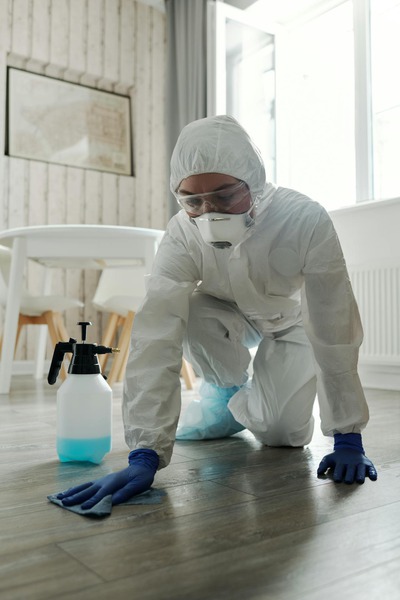Dealing with the aftermath of mold and smoke damage can be overwhelming, but handling it with care is crucial to maintaining your health and that of your loved ones. Whether you’re dealing with a recent incident or remnants of previous damages, understanding the right cleaning steps can prevent various health issues. Let’s explore some important aspects of mold and smoke damage cleanup.
Recognizing the Dangers
Mold and smoke are not just nuisances; they can pose serious health risks if not managed correctly. Mold can trigger allergic reactions, respiratory issues, and even neurological problems in severe cases. Smoke, often accompanied by soot, can exacerbate breathing difficulties and lead to lung damage, especially in those with pre-existing conditions. Recognizing these dangers is the first step in taking the right precautions during cleanup.
Assessing the Damage
Before starting the cleanup process, it’s vital to assess the extent of the damage. This involves identifying areas affected by mold and smoke, examining the type of materials impacted, and determining the severity of contamination. Accurate assessment helps formulate an effective cleanup strategy and decide whether professional help is needed.
Tools You Will Need
-
Protective gear like masks, gloves, and goggles
-
HEPA vacuum cleaner
-
Industrial-grade dehumidifier
-
Mold removal solutions or smoke stain removers
-
Air purifiers with HEPA filters
Creating a Safe Environment
One of the top priorities during mold and smoke cleanup, especially when working with the best Langley property restoration services, is ensuring a safe environment. This means setting up proper ventilation to disperse any airborne particles. Keep windows and doors open whenever possible and employ fans to aid air circulation. Additionally, wearing protective gear is essential to prevent direct contact with contaminants, thereby protecting your skin and respiratory system effectively..
Ventilation Techniques
-
Open all windows and doors to maximize airflow
-
Use exhaust fans to direct contaminated air outside
-
Employ air purifiers to filter out smaller particles
-
Ensure the HVAC system is equipped with clean filters
Tackling Mold Issues
Early detection and removal are crucial in preventing mold from spreading. Scrub the affected areas with a mold-specific cleaning solution. For larger infestations, consider removing and replacing the affected materials. Keep in mind that moisture control is key. Investing in a dehumidifier can be extremely effective in maintaining an environment that discourages mold growth.
Common Mold-Prone Areas
-
Bathrooms and kitchens
-
Basements
-
Attics
-
Carpets and beneath floorboards
-
Behind walls with plumbing
Handling Smoke Damage
Smoke damage often requires different techniques due to the soot and odors that permeate surfaces. Start by thoroughly cleaning surfaces using specialized cleansers. Washing walls, ceilings, and even hard surfaces like tables and floors can significantly reduce residues. Ensure soft furnishings are cleaned professionally to remove entrenched smells.
Effective Odor Removal Techniques
-
Wash fabrics with vinegar or baking soda solutions
-
Use ozone generators for severe odor issues
-
Provide adequate ventilation and sunlight
-
Consult professionals for persistent problems
Understanding Health Implications
Cleaning up mold and smoke damage is not just about restoring your property but also about safeguarding your health. Exposure can lead to both immediate and long-term health consequences. Protecting vulnerable family members, like children or the elderly, is especially significant because they are more susceptible to adverse effects.
Seeking Professional Help
When mold and smoke damage is extensive, involving professional services can be a game-changer. Experts can offer reconstruction services tailored to your needs, ensuring that the damage has been thoroughly addressed. A complete restoration can involve structural repairs and thorough scrubbing of all affected areas, providing peace of mind and a clean, healthy home.
Prevention Measures
Once you’ve cleaned up, it’s crucial to prevent future mold and smoke damage. Regular maintenance checks are beneficial in spotting early signs of mold growth or fire hazards. Installing smoke detectors, ensuring proper insulation, and checking for water leaks regularly can also make a significant difference.
Simple Ways to Prevent Mold
-
Fix leaks promptly
-
Ensure good ventilation in moisture-prone areas
-
Regularly clean and dry water-prone surfaces
-
Use mold-resistant paints in vulnerable areas
Fire Safety Tips
-
Install and maintain smoke alarms
-
Create a family emergency plan
-
Avoid overloading electrical outlets
-
Keep flammable materials away from heat sources
Community Support and Resources
For those residing in narrow geographic locations, fire damage restoration in Coquitlam might be a search term that turns up valuable services indispensable to the process. Contacting local community groups or support networks can provide additional resources and expertise. Many communities offer emergency response services or volunteer groups ready to lend a hand in times of need.
The Psychology of Cleanup
The emotional toll of dealing with mold and smoke damage should not be underestimated. The stress of restoring your home can be significant, not just physically but also mentally. Finding support through friends, family, or professional counseling can help cope with the anxiety and stress that often accompany these arduous tasks.
Final Thoughts
Cleaning up and restoring your home after mold or smoke damage is no small feat. Each step requires attention and care, from ensuring safety during the cleanup to taking the proper preventive measures. While there’s no one-size-fits-all solution, understanding the challenges and having access to the right resources can make the process smoother. Remember, ultimately, it’s about creating a safe and healthy environment for you and your family.
